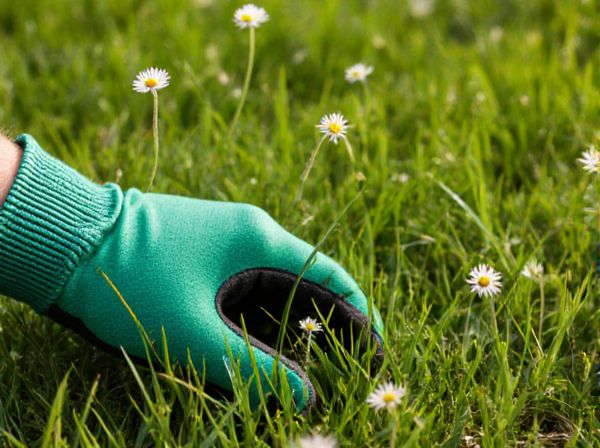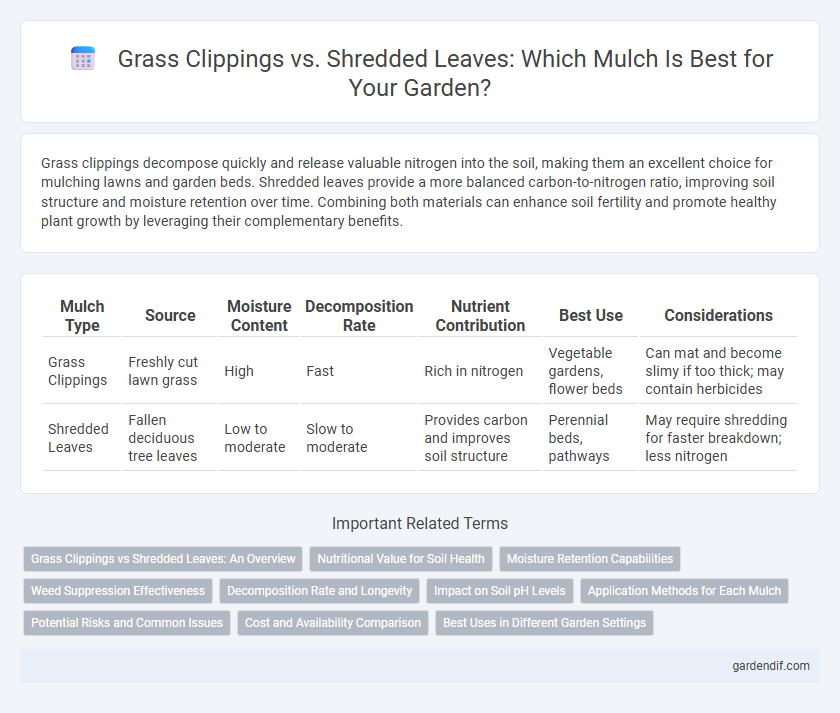
Grass clippings vs shredded leaves Illustration
Grass clippings decompose quickly and release valuable nitrogen into the soil, making them an excellent choice for mulching lawns and garden beds. Shredded leaves provide a more balanced carbon-to-nitrogen ratio, improving soil structure and moisture retention over time. Combining both materials can enhance soil fertility and promote healthy plant growth by leveraging their complementary benefits.
Table of Comparison
| Mulch Type | Source | Moisture Content | Decomposition Rate | Nutrient Contribution | Best Use | Considerations |
|---|---|---|---|---|---|---|
| Grass Clippings | Freshly cut lawn grass | High | Fast | Rich in nitrogen | Vegetable gardens, flower beds | Can mat and become slimy if too thick; may contain herbicides |
| Shredded Leaves | Fallen deciduous tree leaves | Low to moderate | Slow to moderate | Provides carbon and improves soil structure | Perennial beds, pathways | May require shredding for faster breakdown; less nitrogen |
Grass Clippings vs Shredded Leaves: An Overview
Grass clippings provide a nitrogen-rich mulch that decomposes quickly, enhancing soil fertility and promoting healthy lawn growth, while shredded leaves offer a carbon-rich mulch that improves soil structure and moisture retention over a longer period. Using grass clippings as mulch helps speed up nutrient cycling, but shredded leaves are preferred for protecting plant roots during colder months due to their insulating properties. Combining both materials can create a balanced mulch that supports diverse soil health and plant needs.
Nutritional Value for Soil Health
Grass clippings provide a high nitrogen content, which accelerates decomposition and enriches soil fertility effectively. Shredded leaves contribute a balanced mix of carbon and micronutrients, promoting long-term soil structure and microbial activity. Combining both mulches optimizes nutrient cycling, supporting robust plant growth and sustained soil health.
Moisture Retention Capabilities
Grass clippings excel at moisture retention due to their high nitrogen content and dense texture, which helps lock in water and promotes soil hydration. Shredded leaves, while lighter and less dense, create a breathable mulch layer that reduces evaporation and enhances air circulation, indirectly supporting moisture levels. Choosing between them depends on specific garden needs: grass clippings for rapid moisture retention and nutrient boost, shredded leaves for balanced moisture management and soil aeration.
Weed Suppression Effectiveness
Grass clippings decompose quickly, providing a thin layer that offers limited weed suppression compared to shredded leaves, which create a denser, longer-lasting mulch barrier that effectively inhibits weed growth. Shredded leaves allow better moisture retention and block sunlight more efficiently, reducing weed seed germination and growth over time. Their slower breakdown maintains soil coverage longer, making shredded leaves a superior choice for effective weed suppression in mulching practices.
Decomposition Rate and Longevity
Grass clippings decompose rapidly due to their high nitrogen content, providing quick nutrient release but requiring frequent replenishment as mulch. Shredded leaves break down more slowly because of higher carbon levels, offering longer-lasting coverage that improves soil structure over time. Balancing both materials optimizes mulch longevity and nutrient availability in garden beds.
Impact on Soil pH Levels
Grass clippings tend to have a neutral to slightly acidic effect on soil pH due to their nitrogen content, promoting balanced nutrient availability. Shredded leaves, depending on their type, can acidify the soil more significantly, especially if they come from deciduous trees like oak or maple. Monitoring soil pH when using these mulches helps maintain optimal conditions for plant growth.
Application Methods for Each Mulch
Grass clippings are best applied as a thin layer directly on lawns or garden beds to avoid matting and promote quick decomposition, enhancing soil nitrogen. Shredded leaves require spreading in thicker layers around trees, shrubs, or flower beds, where their slower breakdown improves moisture retention and suppresses weeds effectively. Both mulches benefit from periodic turning or raking to maintain aeration and prevent compacting, ensuring optimal soil health and plant growth.
Potential Risks and Common Issues
Grass clippings can introduce excess nitrogen into the soil, leading to rapid decomposition and potential nitrogen imbalance, which may harm plant roots and soil microorganisms. Shredded leaves, while slower to decompose, can create mold or fungal growth if applied too thickly or kept too moist, potentially affecting lawn health. Both mulches risk harboring pests or diseases if not sourced from healthy plants and can cause matting or suffocation of grass if improperly applied.
Cost and Availability Comparison
Grass clippings are a cost-effective mulch option since they are typically free and readily available after mowing, making them an accessible choice for most homeowners. Shredded leaves may require additional effort or equipment for collection and processing, but they are often abundant in autumn and also free, depending on local leaf drop. The overall cost is minimal for both, but grass clippings offer continuous supply during the growing season, while shredded leaves are seasonal and may require storage.
Best Uses in Different Garden Settings
Grass clippings provide a nitrogen-rich mulch ideal for vegetable gardens and flower beds, enhancing soil fertility and promoting healthy plant growth. Shredded leaves are better suited for woody plants and shrub borders, as they break down slowly, improving soil structure and moisture retention over time. Utilizing grass clippings in annual planting beds and shredded leaves in perennial or acid-loving plant areas maximizes nutrient cycling and garden health.
Grass clippings vs shredded leaves Infographic

 gardendif.com
gardendif.com